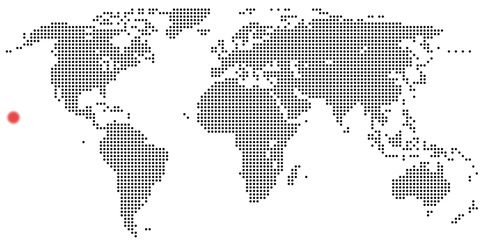
At the beginning of May 2018 a fissure eruption started at Kilauea in Hawaii. The special feature of this eruption was that it did not manifest itself in the summit area of the volcano, nor at Pu'u 'O'o crater, but in the lower part of the East Rift. More precisely, in a populated area of the coastal plains, south of the town of Paoha. The eruption was preceded by a drop in the lava lake level in the Halema'uma'u crater, and the collapse of the Pu'u 'O'o crater: the magma flowed underground and intruded into the lower East Rift. A magmatic corridor was formed and several fissures opened up in the middle of the Leilani settlement. During the first days, old magma was erupted, which was viscous and produced only small lava flows. Then the main phase of the eruption began! Lava flooded the landscape and destroyed large parts of the settlement. After only a few hours lava flows reached the ocean. That was the starting signal for Martin and me. We booked flights to Kona on Big Island and two days later we were on our way, well knowing that it would be difficult to reach the lava at the barriers.
And so it was. When we arrived with our rental car at the scene of the incident, we were already in front of a big roadblock. This was secured by police and national guard. Several attempts to bypass the barrier failed. However, we discovered a private hidden path that started at Forest Road and led to the Lava Tree Monument, which was already in the restricted area. But we wanted to avoid this way if possible: the danger of getting into trouble was too great. Instead, we went the official way and looked for someone who was responsible for the press. We found this person in the form of Major Hickman of the National Guard, whom we were to meet at the Paoha Fire Station. When we arrived there, the Major was not to be found, but we were issued a press card. With it we managed to get through the roadblocks. We followed Highway 132 and saw steam rising behind a ridge. A few hundred meters away from us the inferno was bubbling. But on every side road in the right direction there was a police station that refused to let us pass. At the geothermal power station they also turned us down. Here was no further progress! So, a sms was sent to the major and the next morning we were booked for a press tour to the eruption site. The condition for this was however that the situation was classified as relatively harmless.
Boat ride to the ocean entry
What to do now, with the dawning day? First we went to the airport and organized seats in a helicopter. These were booked up days in advance and we had to be patient for 3 days, after which we made our way to Hilo and searched for the Lava One in the harbor. The silver tour boat made of aluminum was already known to us from our last Hawaii trip in September 2016. In fact some tourists already gathered who wanted to join a tour. And we were lucky, there were still 2 seats available. We paid the 200 USD travel expenses in cash and boarded. As soon as the Lava One had left the sheltering harbor, it became uncomfortable. With full throttle Captain Shayne steered the boat over the waves. The 1 hour trip to Ocean Entry was like a rodeo ride. Already from far away we could see the steam cloud caused by the contact of the lava with the ocean. Finally arrived at the Lava-Ocean Entry, littoral explosions surprised us. One explosion was so strong that lava debris hit just beside the boat. Lapilli pelted on the aluminum roof of the boat and I was grateful for the protection of the roof. Shayne steered the boat dangerously close to the coast. Another danger threatened from below: remarkably large lava rocks were floating in the water! If a boat at full speed collided with one of these lava rocks, it would probably have bad chances. Martin and I were thrilled and decided immediately to take another trip at dawn. The lighting mood was bombastic. To top it off, there were even volcanic flashes in the eruption cloud of a littoral eruption. Last, but not least, the boat was accompanied by a school of dolphins on the return trip.
Pictures of Kilauea volcano
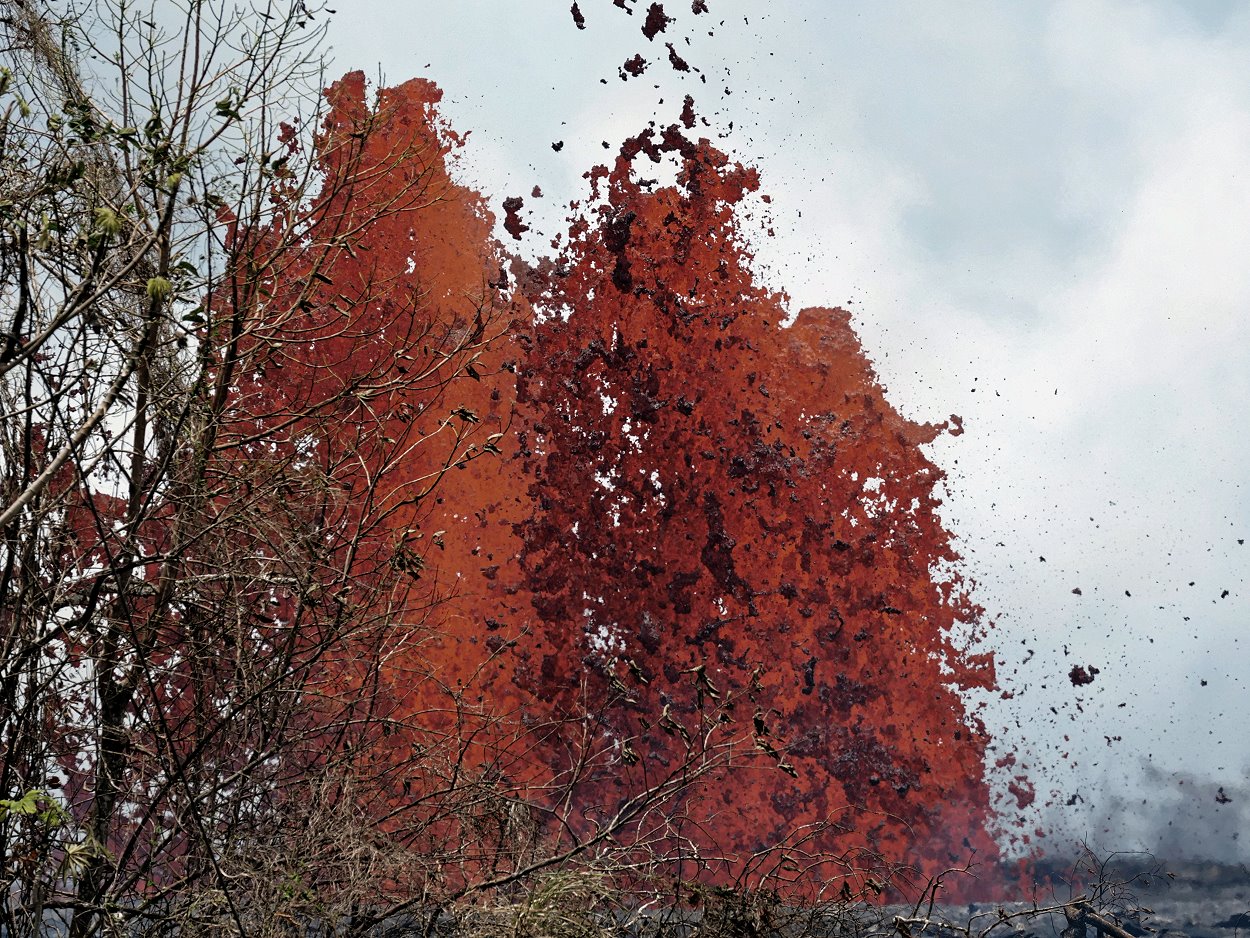
Lava fountains of fissure 22.
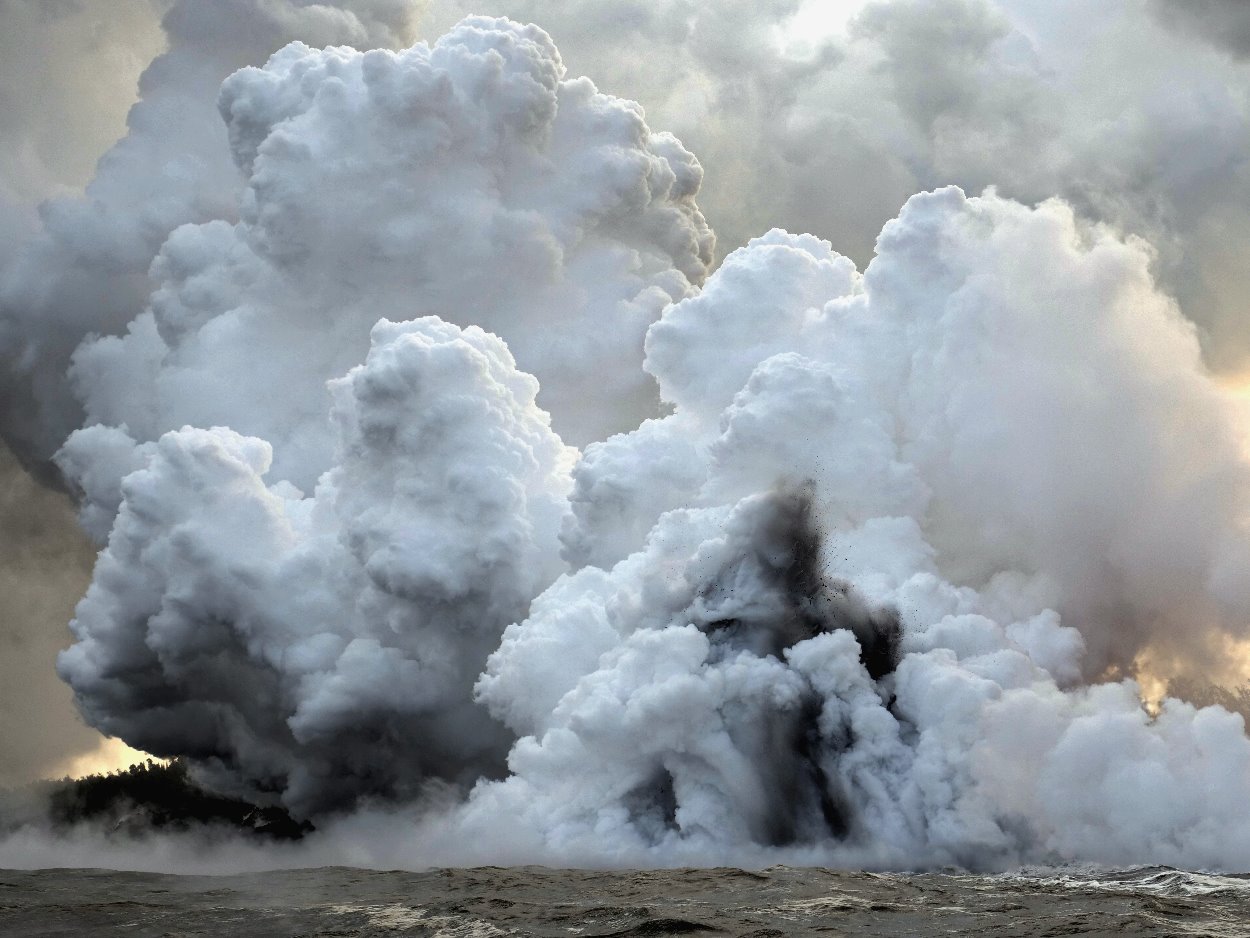
Littoral explosion at ocean entry.
After a late breakfast we and our spirit of adventure were strengthened. We went to the church of Paoha, where the press representatives already arrived. Our goal was to reach the eruption fissure with the help of the National Guard. A little later Major Hickman and his men arrived. The journalists were distributed to 3 vehicles and off they went to the restricted area. After a 10 minute drive we reached Leilani. The streets presented themselves deserted. A quick look into a side street shows that it was interrupted by lava. The tension rose. We stopped at another barrier and had to stay in the car while the men from the National Guard approached the eruption fissure. They wanted to take gas measurements first before we were allowed to come. Two minutes later we were allowed to leave the vehicles. Another briefing followed: we should follow the instructions of the military. As soon as the concentration of sulfur dioxide in the air rose above 15 ppm, the order would be given to put on the gas masks and evacuate. Those who would not immediately follow the instructions would be barred from further press tours. So far, so good! At last the group of photographers was allowed to set off. We could already hear the hissing and rustling of the lava fountains and a few steps later we were offered a fantastic sight: at a distance of 100 m the road ended abruptly at a lava field. A good 150 m further on, 2 fountains gushed out. The red glowing lava columns rose up to 50 m high. The melt hit the ground and fed a wide lava flow which dammed up in a depression and formed a secondary lava lake. Exactly there were still numerous houses a few days ago. The lava erased every trace of them. The National Guard had secured 2 viewpoints for us. One of them was in the garden of a house which was now directly bordering the lava flow. The other one ended before a fluttering band at the end of the street. Half way to its abrupt end it was crisscrossed by fissures. The journalists were divided into 2 groups and were distributed alternately on both locations. To our surprise we stayed in the restricted area for about 90 minutes and were allowed to change positions several times. A luxury that we did not enjoy on later tours.
The same evening we were allowed to accompany Major Hickman and his team a second time. In the twilight the view was even more breathtaking than during the day. There was a lot of activity in the restricted area and the inhabitants of the house were on the lava front. They had taken some volcano photographers into the restricted area. Also other inhabitants of Leilani were onlookers. Residents of the settlement had special passes and were free to move around the restricted area.
Finally the day of the helicopter flight came. After a briefing we boarded the Hughes MD 500 from Paradis Helicopters and felt like we were in an oily sardine can. The flight was carried out without doors, which proved to be relatively fatal: the downwind of the rotor blades generated real blows, which even the image stabilizer of the camera could not compensate. The original plan to use a gimbal was stupidly rejected in favor of greater flexibility. So we enjoyed quite a nice bird's eye view, but from a cinematic point of view the flight was not worth it. In addition, we had a ¾ hour delay and the light was bad. The pilot kept the prescribed flight altitude of 500 m and never once hovered over the lava fountains. Instead he circled over a waterfall for 5 minutes.
Pictures of the Leilani eruption

Martin, Marc and the helicopter.
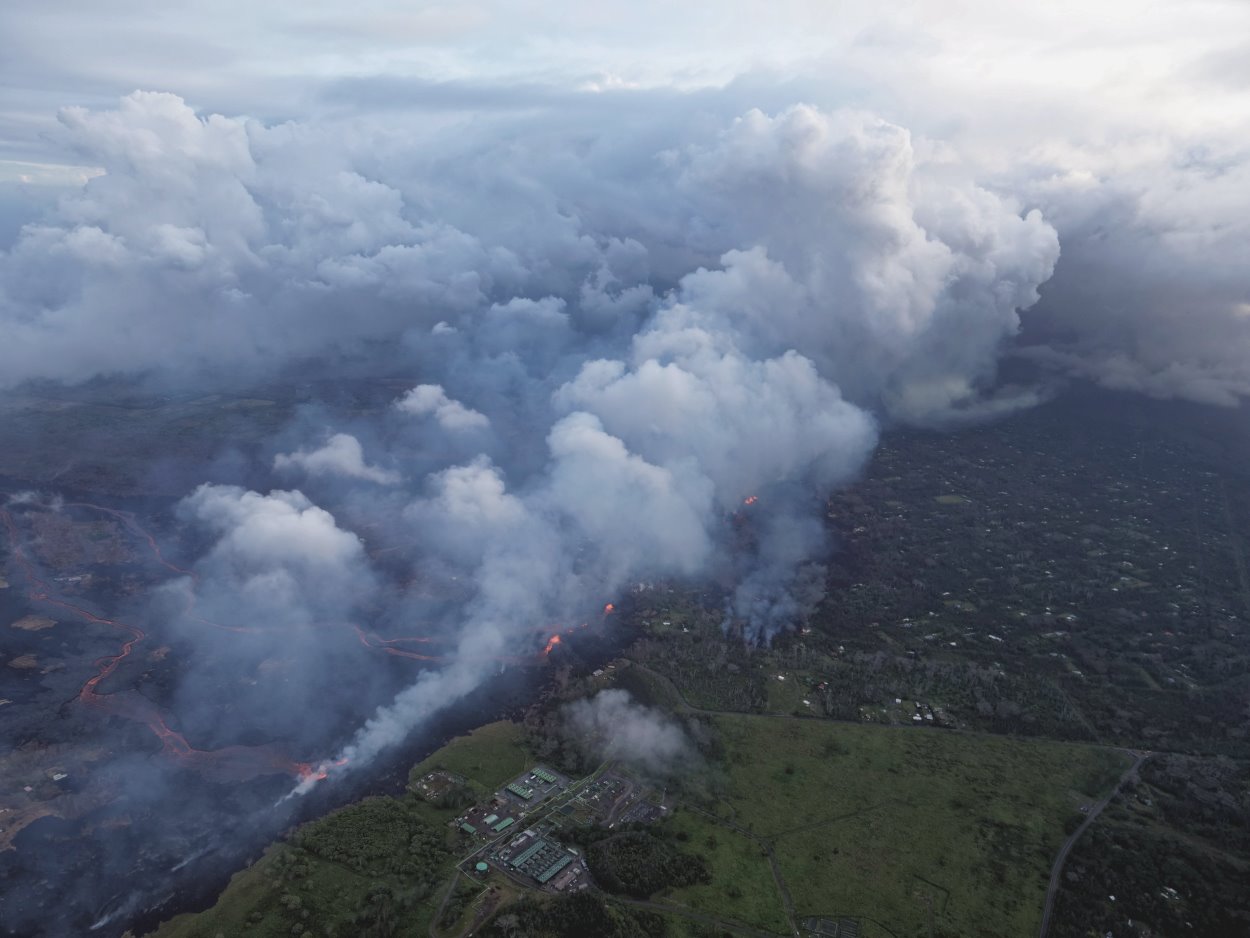
Leilani and the power plant.
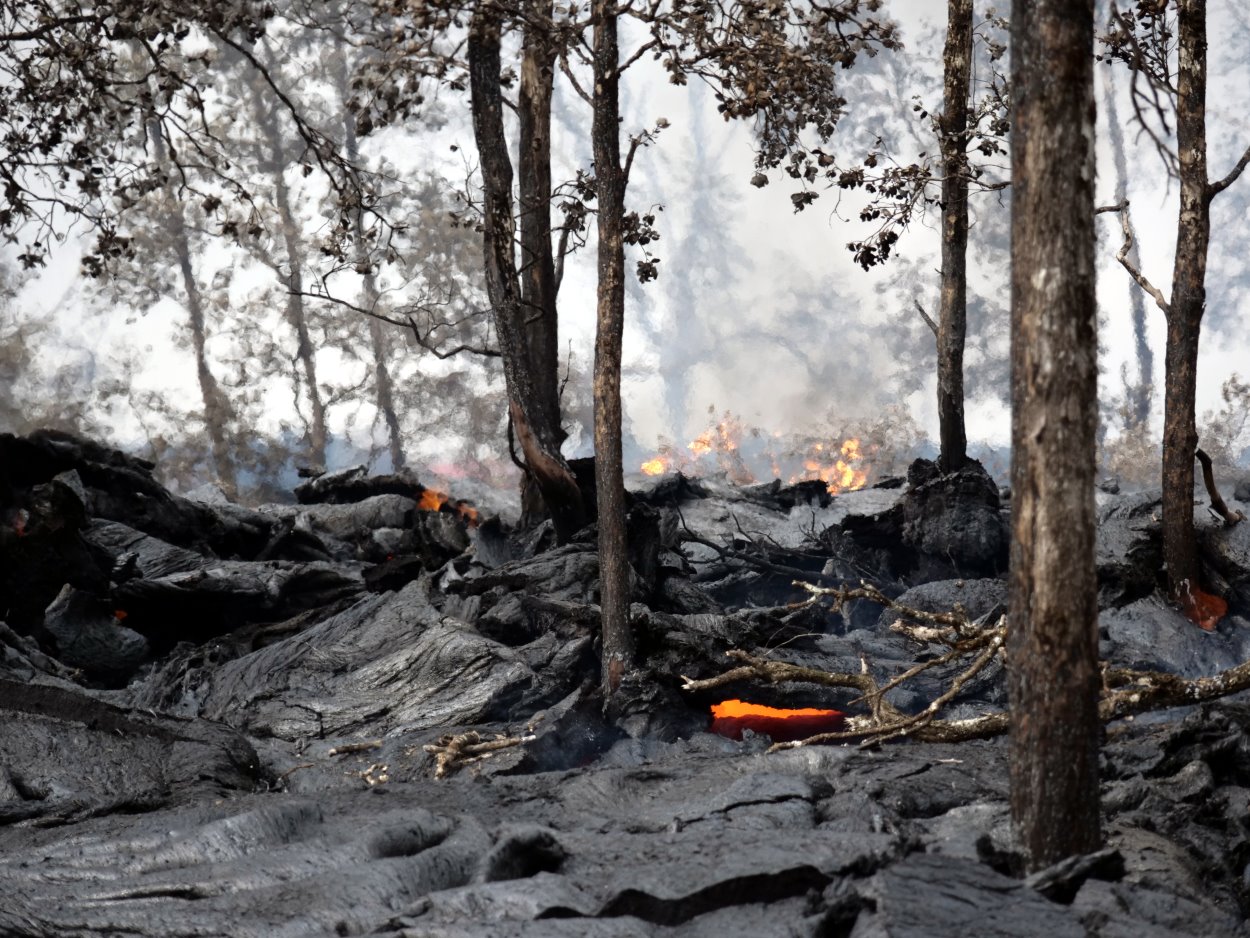
The forest at the edge of the creeping path.

Lava fountains of column 8.
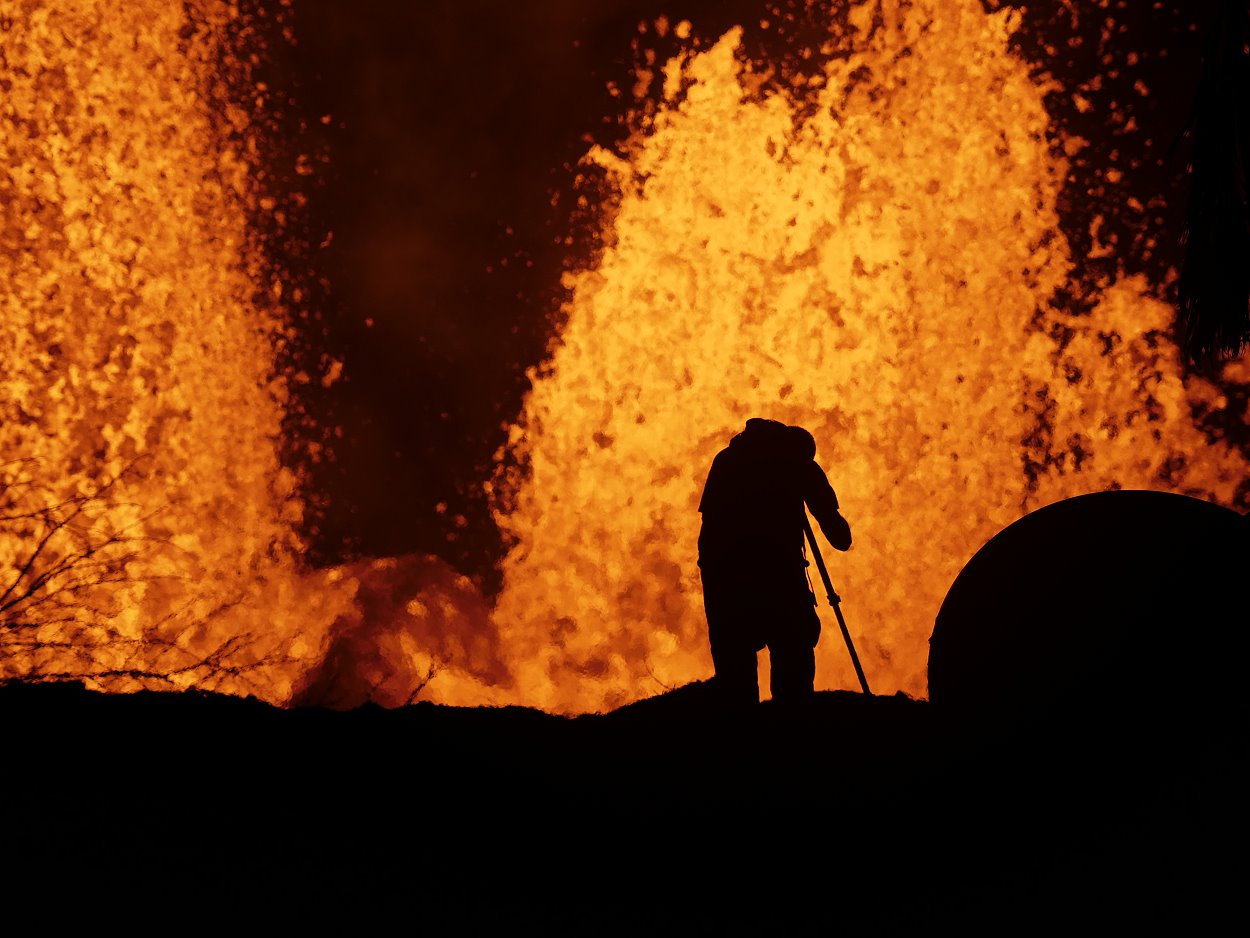
Martin in front of the lava fountains.
Lavafontains at fissure 8
We drove to the nearby Forest Road and parked the car at its end. The area did not inspire much confidence. At the edge of the dirt road were burnt out car wrecks, unmistakable signs that visitors are not welcome here. At the end of the street, a narrow private road began, winding through reeds. We followed the path, passed some unguarded road spiders and suddenly found ourselves in the middle of Leilani. This part of the settlement had obviously been evacuated. The houses stood in a large distance, with woods and bushes in between. We followed the road towards the red light and soon looked into the blazing maw of the inferno. Lava as far as the eye could see. At the edge burning trees and parts of houses. Far behind and hardly to be recognized by the flickering air, a lava fountain rose. Blue flames flickered from cracks in the ground: Methane fire! The methane was caused by the carbonization of biomass in the ground. The lava not only killed above ground, but also life in the ground.
After taking some pictures, we crept on through the deserted streets and after what felt like an eternity we reached fissure 8.
The whole thing was reminiscent of a scene from a war movie. As we approached the barrier Lapilli crunched under our feet. In the air hung sulfur gases and the sound of lava fountains. The barrier was located at an intersection. We turned off and followed the path to its end at the lava flow. The masts of power lines were charred and bent over. The cables were hanging loose. It was raining lapilli. Behind charred trees 2 lava fountains rose into the night sky. They were about 80 - 90 m high and about 300 m away. Nevertheless I felt their heat on my face. We followed another road parallel to the lava flow towards the fountains. Bigger lava chunks rained down and I cursed myself because I didn't have a helmet with me. But the chunks were quite light and bounced off my wooden head without any effect. Suddenly the vegetation thinned out and we were practically standing right in front of the fountains. The molten rock shot up from the depths of the earth and seemed to reach for the stars. But gravity put a quick end to the flight of fancy. Seemingly liquid like water, the molten rock poured onto the ground and flowed towards the ocean. Heat waves were breaking out and the sweat was running in streams. It couldn't get any closer without a protective suit! We looked into the maw of hell and lost ourselves in our photo work. What a finale of our journey! But everything beautiful has an end and we did not want to overstrain our previous luck. So we left Leilani on our crawl way. At the parking lot of the Lava-Tree-Monument 2 police cars were waiting for us. Thank God not for us but for the driver of a jeep parked there. Nevertheless we got a warning. I felt like a little schoolboy and not like an experienced volcano observer.
The next morning - our last day in Hawaii - we read on the internet that the lava flow had hit our crawl space. So we left Hawaii with the feeling that we had made the right decisions.


